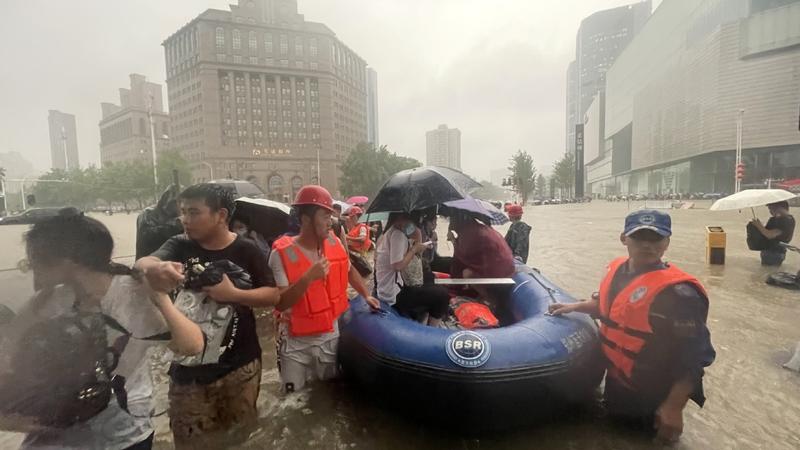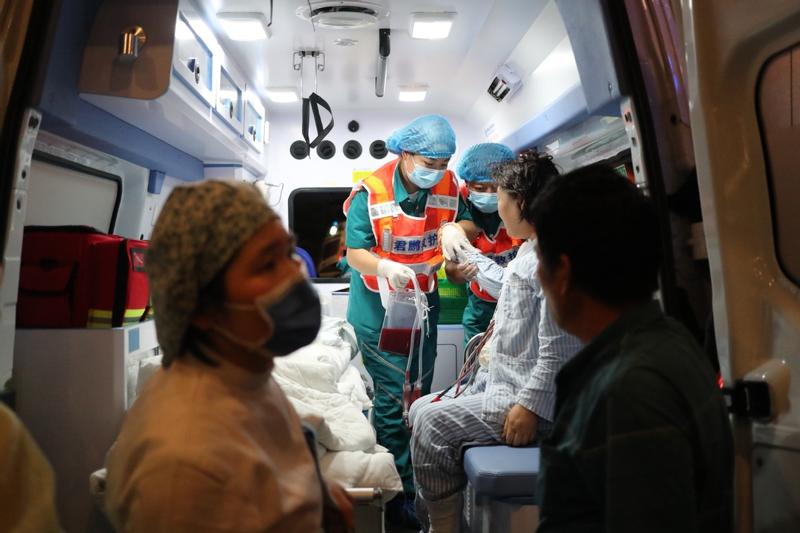Inland cities need to prepare for possible disasters
 Rescuers evacuate trapped residents at an intersection in Zhengzhou, Henan province, on Tuesday. (YAN ZIDAN / FOR CHINA DAILY)
Rescuers evacuate trapped residents at an intersection in Zhengzhou, Henan province, on Tuesday. (YAN ZIDAN / FOR CHINA DAILY)
Metro Line 5, the longest and one of the busiest subway lines in Zhengzhou, capital of Henan province, transports 500,000 commuters to their destinations every day.
As a torrential downpour swept the city on Tuesday evening, about 500 passengers were trapped in a flooded subway car on this line. Twelve of them died, five were hospitalized and the remainder were rescued.
Between 4 pm and 5 pm, Zhengzhou witnessed 201.9 millimeters of precipitation, an hourly record for the Chinese mainland.
A woman surnamed Li was just one of the passengers who experienced fear and desperation.
On Tuesday afternoon, Li left work early and headed for the subway. After boarding the train, she was not unduly worried when it made a number of emergency stops from time to time.
"Then the train made another emergency stop between stations and became stuck there. I could see the water rising and it began to pour into the carriage," she told China Youth Daily.
Following instructions from subway employees, Li and other trapped passengers grabbed a railing and waded through a passageway in the subway tunnel to reach a station just over 200 meters away.
 Cars stand in floodwater in a Zhengzhou neighborhood on Wednesday. (CHEN GENGSHENG / FOR CHINA DAILY)
Cars stand in floodwater in a Zhengzhou neighborhood on Wednesday. (CHEN GENGSHENG / FOR CHINA DAILY)
The passageway was narrow, so passengers had to walk in a line to wade through the water in darkness. A few walking in front of the group managed to reach a safe area, but most of the passengers were forced to return to the subway car, including Li, as water surged fiercely through the tunnel.
As they waited anxiously to be rescued, Li saw that the water level was continuing to rise, eventually reaching as high as the passengers' chests and necks. They climbed on the seats to keep their heads above water.
Some took turns to help lift other passengers' children above their heads.
"I stood in the middle of the group. The water level continued to rise. Some people started to cough, some were breathing heavily due to a lack of oxygen, and some were shaking. The elderly, children and pregnant women were particularly affected by having to stay in the water for so long," Li said.
"I dared not tell my parents that I was trapped, so I only texted my cousins. I also started to arrange my affairs in case I died.
"I could sense the fear around me in the subway car. Someone tried to smash a window, but other passengers stopped him," she said.
"Everyone was trying hard to contact their families, friends and others for help."
Ding Xiaopei, who was also trapped in the car, posted a video on a social media platform asking for help. The footage showed the water rising high in the car.
"The rainwater is continuing to rise and my mobile phone is about to run out of battery. I don't know whether this will be my last post," she said in the video.
Ding, a reporter for a local radio station, worked in a temporary liaison role to update passengers on the rescue process and cheer them up.
 A Zhengzhou resident searches for his electronic bicycle, which was submerged during the torrential rain. (WANG JING / CHINA DAILY)
A Zhengzhou resident searches for his electronic bicycle, which was submerged during the torrential rain. (WANG JING / CHINA DAILY)
As time passed, the passengers became quieter in order to save energy.
A male passenger surnamed Zhang told China Youth Daily that when he was deep in the water he thought of his father.
When Zhang was about to lose consciousness, he thought back to his childhood, when he sat on his father's shoulder while his parent held an umbrella for him.
Zhang described the passengers' excitement on seeing a rescue team through the subway car window, comparing it to a "desperately poor man winning the lottery".
Rescuers brought ropes to the scene and carried exhausted passengers from the subway car.
Zhang said he is habitually pessimistic, but when the rescuers arrived, "all I thought about was my family and the love I gained from them," he said.
"By the time the rescuers showed up, the water was at a very high level outside the window. They broke the door and window and pulled passengers out one by one. Pregnant women were rescued first, then children, then other women," Li said.
"Everyone was comforting each other and helping those around them. Men were letting women go first and everyone was making way for any sick or disabled passengers."
By Thursday, the city's subway network had been closed.
The National Meteorological Center said that from Saturday morning to Wednesday morning, precipitation in Zhengzhou exceeded the annual average of 641 millimeters.
 Medical workers at the No 1 Hospital Affiliated to Zhengzhou University, which was severely impacted by the torrential rain, transfer patients to other institutions on Wednesday. (WANG JING / CHINA DAILY)
Medical workers at the No 1 Hospital Affiliated to Zhengzhou University, which was severely impacted by the torrential rain, transfer patients to other institutions on Wednesday. (WANG JING / CHINA DAILY)
Test for the city
Authorities in Zhengzhou said the rainstorm caused water to accumulate in a parking lot next to the subway line. A wall was built to prevent the water entering the subway, but waters from the downpour broke through the wall at about 6 pm on Tuesday and flowed into the subway.
The section of the subway where the passengers were trapped is located near Zhengzhou North Railway Station.
Zhang Qiang, director of Beijing Normal University's Risk Control Innovation Research Center, said those trapped in the subway car were like "people in a water tank", as it was extremely difficult for them to escape.
It was also impossible for them to move to higher areas to avoid danger, he said.
He told China Newsweek that in view of this, there were few practical rescue options.
However, Zhang said the subway system should have a mechanism to enable a quick decision to be reached to stop services in such extreme weather conditions.
In Beijing, which was hit hard by unprecedented torrential rains on July 21, 2012, resulting in 79 deaths, authorities have taken measures to prevent possible disasters.
Last month, when heavy rain was forecast in the capital, many such measures were taken, such as shutting down subway lines, encouraging people to work from home and closing schools and parks.
Zhang Jin, an associate researcher of climate change at Zhengzhou University, wrote in an article that people should be prepared for the possibility of disasters.
"Torrential rain usually occurs in coastal cities, but Zhengzhou usually has very little rainfall," she wrote, adding that as a professional, she had not initially realized the danger on Tuesday.
"The tragedy in Zhengzhou shows that inland cities usually know little about urban flood disasters," she said.
 A dog floats on foam boards on a major road in the downtown area of the city. (ZHANG CONG / FOR CHINA DAILY)
A dog floats on foam boards on a major road in the downtown area of the city. (ZHANG CONG / FOR CHINA DAILY)
Zhengzhou is one of the major Chinese cities that has spearheaded a "sponge city" program, which aims to absorb and capture rainwater for use and to control floods.
The city was chosen to pilot the program in 2016. It plans to build 73 storage ponds with a total capacity of 820,000 cubic meters and extend its rainwater drainage pipe network to 2,576 kilometers.
Lyu Hongliang, an expert with the China Academy of Urban Planning and Design, said Zhengzhou's urban flooding prevention and control capability corresponds to a city of its size.
"If the capability is designed in accordance with extreme weather at the time, it will result in serious waste," he was quoted as saying by Chinese financial media outlet Yicai.
However, Lyu stressed that it is important to design a city's disaster mitigation capability "someway beyond what is usually required".
He suggested allocating some areas especially for urban development disaster prevention and control efforts.
In addition to strengthening the drainage pipe network, more natural drainage channels, or spillways, should be built in newly urbanized areas, he said.
Zuo Qiting, a professor at Zhengzhou University's School of Water Conservancy and Engineering, said the sponge city program alone is not sufficient to cope with urban flooding as severe as that seen in Zhengzhou.
In addition to improving flood control infrastructure as much as possible and stepping up early warning systems, Zuo suggested holding more emergency drills as precautionary measures to tackle urban flooding on the scale witnessed in the city.
Contact the writers at luowangshu@chinadaily.com.cn


